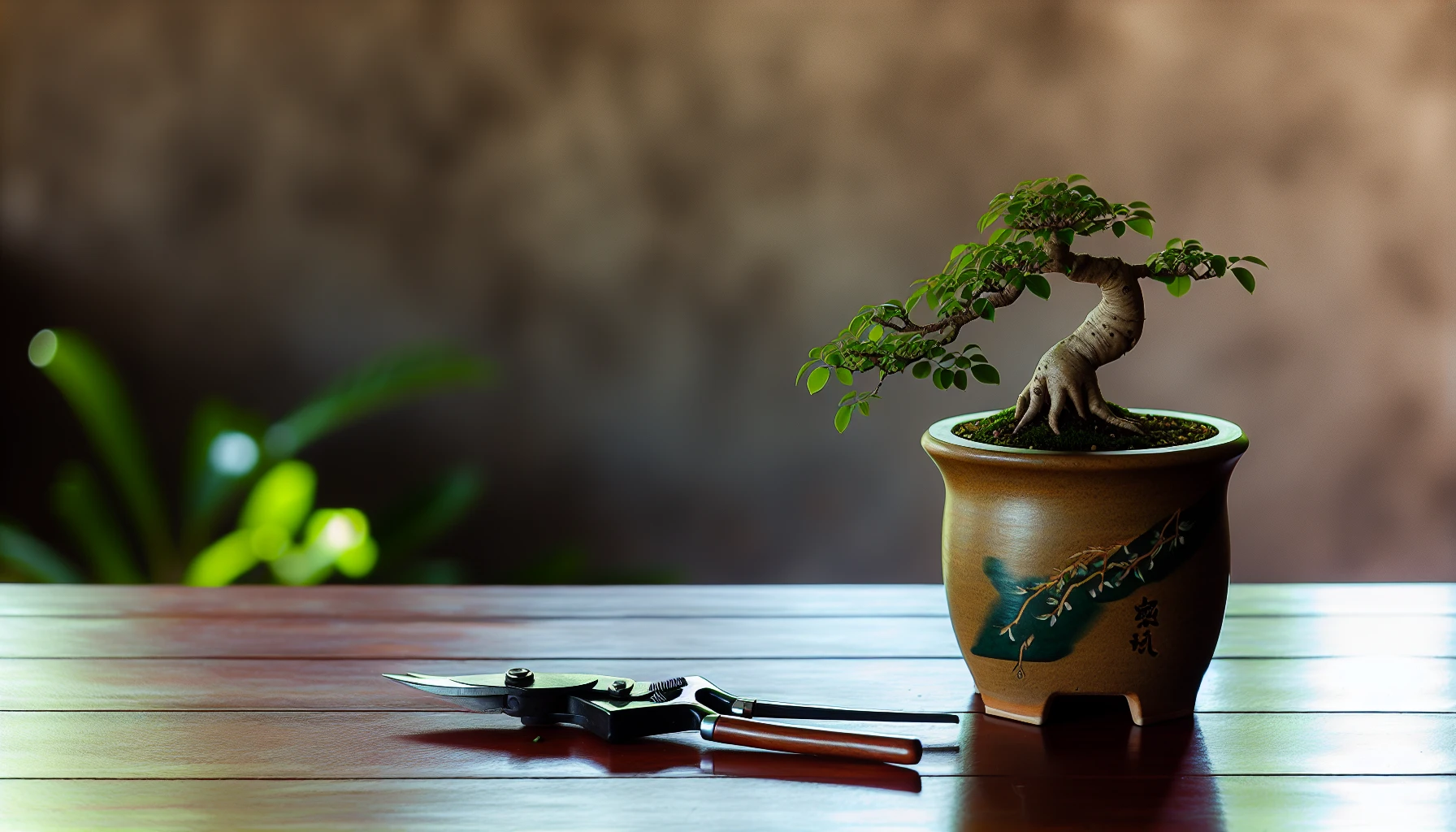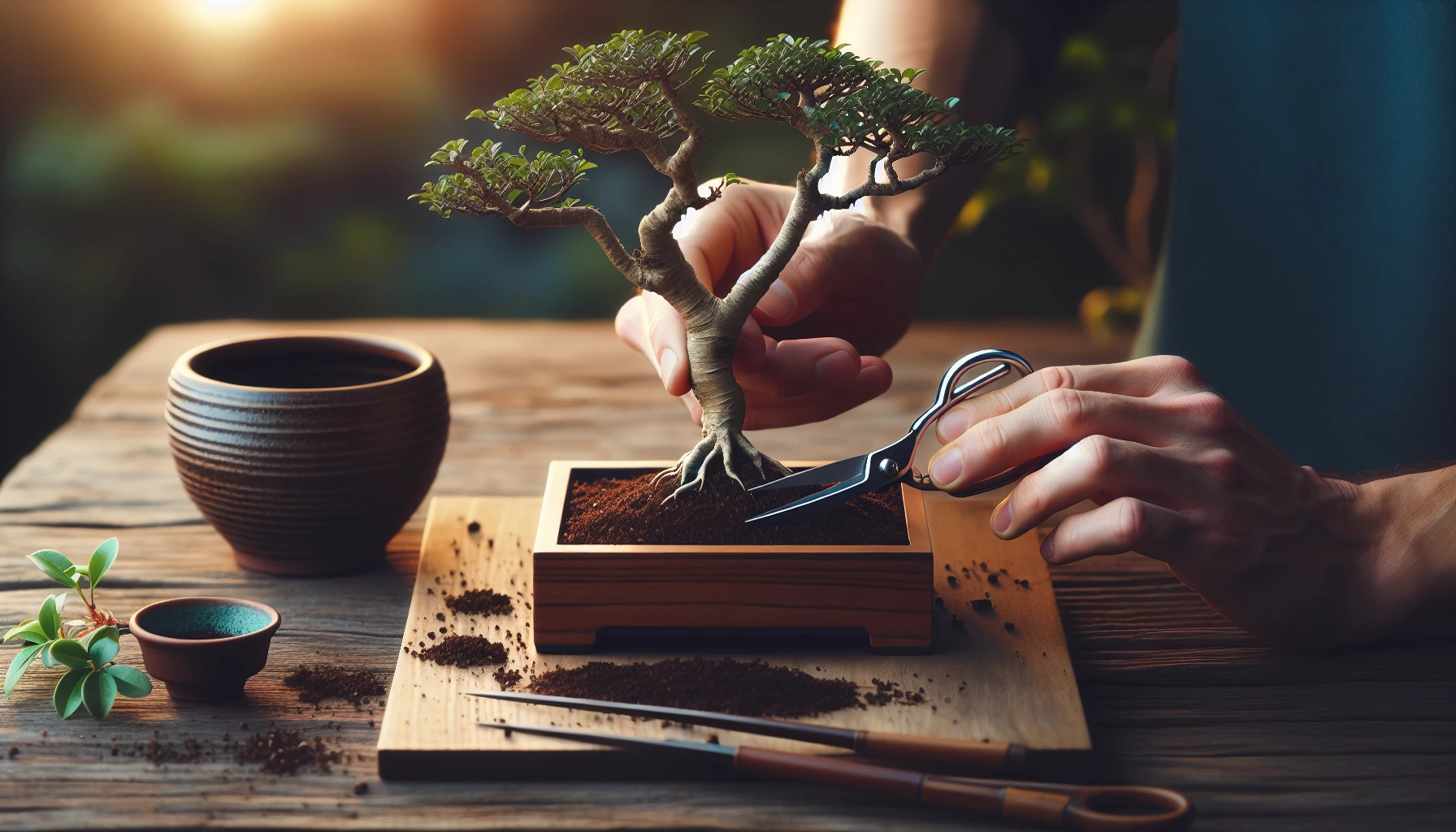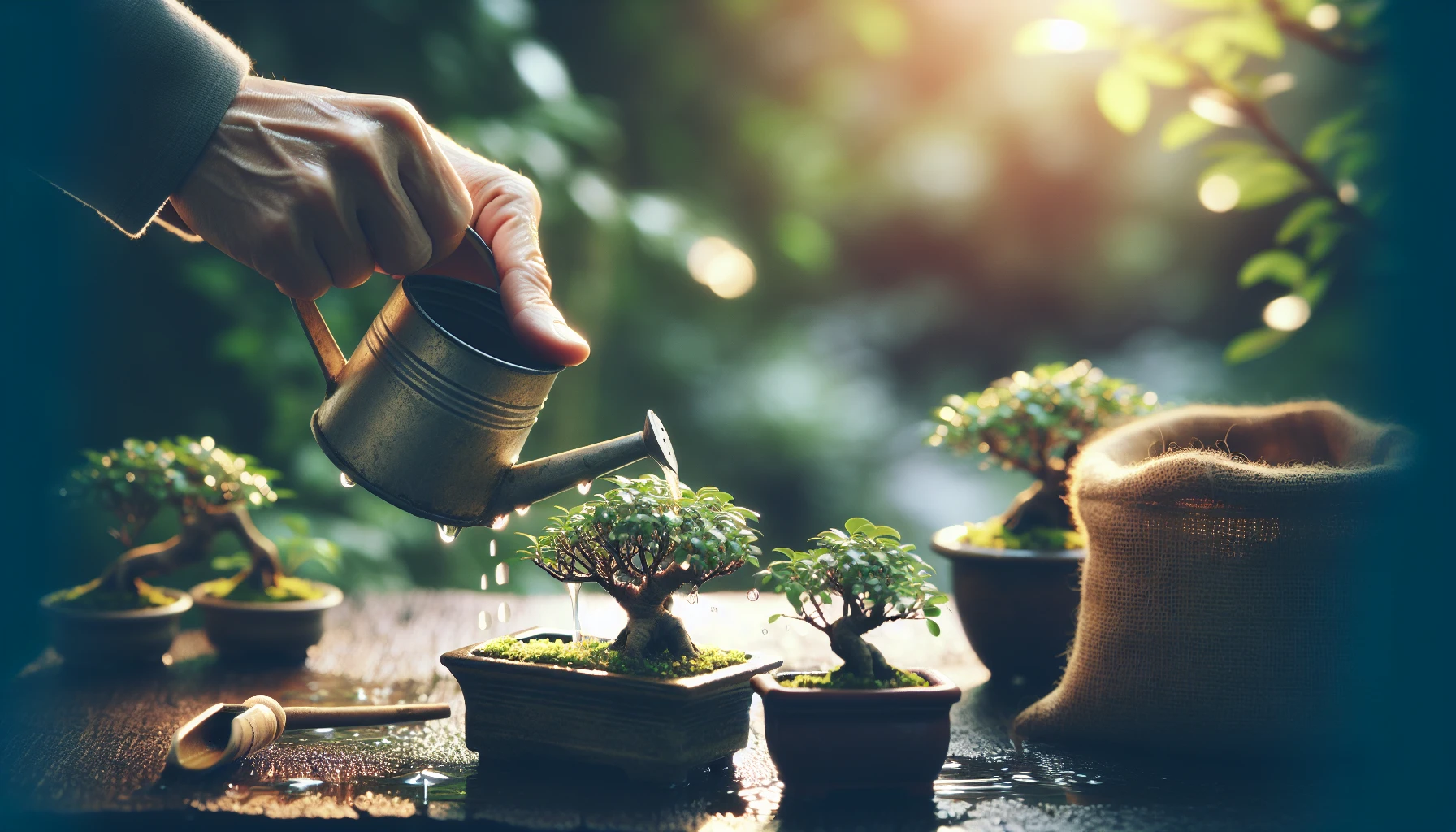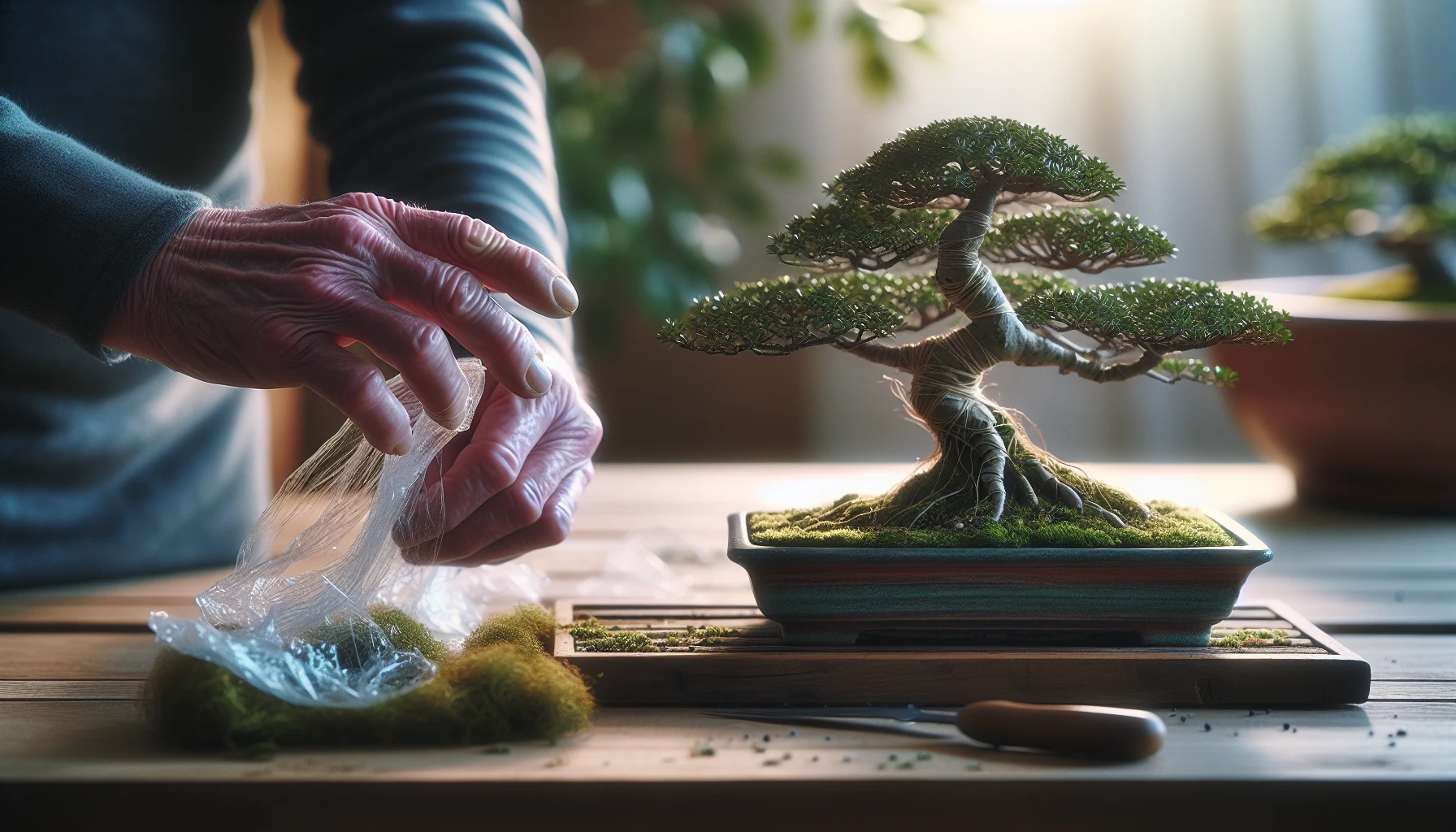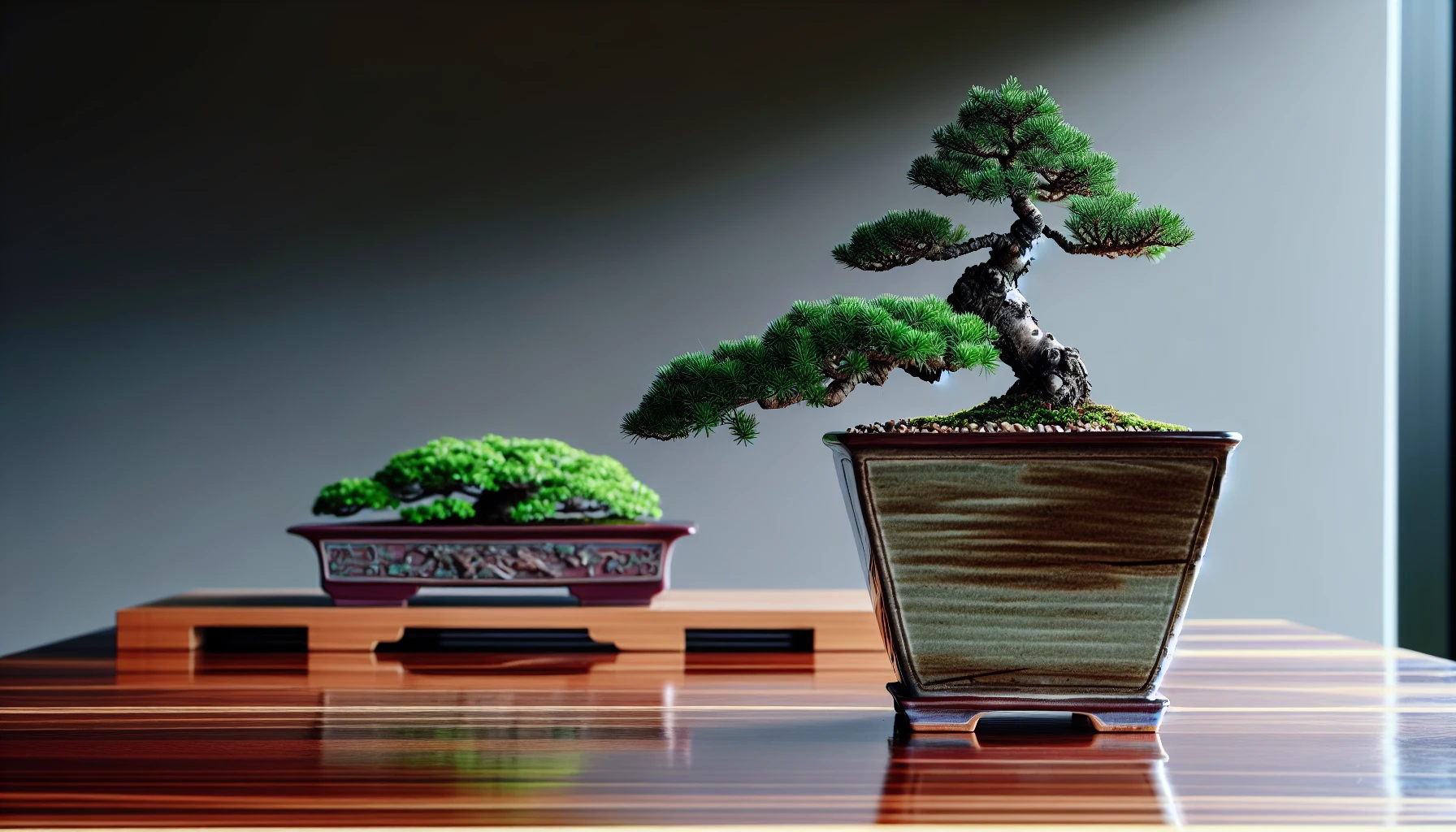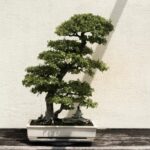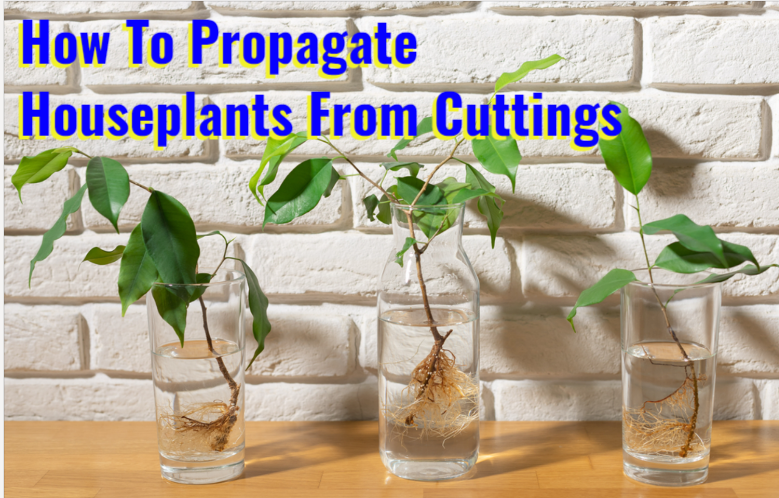HousePlantJoy is supported by our audience. When you purchase through one of our links, we may earn a small affiliate commission. As an Amazon Associate I earn from qualifying purchases. Your cost is not affected.
==================
Imagine cultivating a breathtaking miniature tree in your home, a piece of living art showcasing your skill and patience. Welcome to the bonsai world, where you can experience the joy of growing these tiny wonders! In this guide, we will walk you through the process of mastering bonsai from cuttings, teaching you everything from basic techniques to advanced methods that will elevate your miniature trees to new heights.
Key Takeaways
- Unlock the rewarding world of bonsai with cuttings and learn how to propagate your miniature tree!
- Explore hardwood and softwood cuttings for unique advantages, select a species that suits you best, and then prepare & plant correctly.
- Prune, fertilize & water regularly to grow an attractive masterpiece; add advanced techniques like air layering or root training for extra flair!
The Basics of Bonsai Cuttings
Bonsai trees are a beautiful and rewarding hobby, but starting from seeds can take years to produce a mature tree. Instead, bonsai enthusiasts can propagate these miniature trees from cuttings, allowing them to grow much faster with the added benefit of retaining the characteristics of the parent tree.
We will examine the types of cuttings and the process of selecting the best tree species for successful propagation.
Types of Cuttings: Hardwood vs. Softwood
Hardwood and softwood cuttings offer different opportunities for growing bonsai. Hardwood cuttings are taken from deciduous trees during their dormant state in late winter or early spring, an excellent moment for pruning thick branches of mature trees. Softwood cuttings, on the other hand, are taken from evergreen trees during the active growing season in spring. These cuttings root more easily and quickly, making them popular among bonsai enthusiasts.
Both hardwood and softwood cuttings have their unique advantages, depending on the species and your personal preferences. Hardwood cuttings provide better chances of success during the dormant season, while softwood cuttings require more attentive watering but reward you with quicker rooting and growth. The choice is yours to explore and style your bonsai trees with these exciting options.
Selecting the Right Tree Species for Cuttings
Selecting the appropriate tree species for your bonsai cuttings is pivotal for their survival and growth. Hardy species that grow quickly and have desirable characteristics, such as small leaves and a naturally interesting growth pattern, are ideal candidates. Some popular species for bonsai cuttings include:
- Azalea
- Elm
- Maple
- Junipers
- Ligusters
- Boxwoods
- Chinese elm
When selecting tree species for cuttings, it’s important to consider each species’ specific needs, such as soil preferences and pruning requirements. Aligning the species with the appropriate conditions can assist in guaranteeing that your cuttings will flourish into stunning bonsai.
Preparing and Planting Your Bonsai Cuttings
Careful preparation and planting are required for your bonsai cuttings to be successful. Proper techniques are essential for collecting and trimming cuttings, choosing the right bonsai soil and container, and planting for successful propagation.
We will learn how to optimally initiate the growth of your miniature trees, ensuring they become healthy trees.
Collecting and Trimming Cuttings
Selecting healthy branches for bonsai cuttings is the first step towards successful propagation. Look for a few branches with:
- beautiful movement
- taper
- ramification
- a vibrant terminal bud that hasn’t been cut
The optimal time to collect cuttings is in early spring, right before the tree begins to grow, or early fall for certain species such as spruce.
Trimming your bonsai cuttings properly is essential for their growth. Here are some steps to follow:
- Begin by removing any undesired or excessive growth to shape the bonsai tree into the desired style.
- Prune the leaves and branches to promote smaller and more ample leaf development.
- Shape the bonsai tree effectively for an amazing result.
Choosing the Right Bonsai Soil and Container
The right bonsai soil and container are essential for your cuttings to grow properly. Bonsai soil should have the following characteristics:
- Excellent drainage
- Moisture retention
- Proper aeration
- Capacity to retain and release nutrients
Different tree species have different soil preferences, so it is important to consider moisture retention, drainage, and nutrient content when making your choice. To keep the soil slightly moist, which many tree species prefer, be mindful of watering and drainage practices.
The ideal bonsai container for cuttings should have the following characteristics:
- Slightly wider and less deep than most nursery containers for a given volume of soil
- Made of plastic for affordability
- No deeper than the width of the cutting’s trunk at soil level
- A signature or chop on the bottom side of the bonsai pot for added value
When selecting a container, consider these factors to ensure the best choice for your bonsai cuttings.
Planting Techniques for Successful Propagation
Correctly planting your bonsai cuttings in terms of depth and angle is key to successful propagation. Plant cuttings at a 2-3 inches depth in the soil for optimal growth. The best angle to plant a bonsai cutting is at a right angle to the trunk, giving it the best chance of success.
Different tree species have different growth habits, root systems, and care requirements, so following specific guidelines for each tree species when planting bonsai cuttings will help ensure successful propagation. Here are some crucial guidelines to follow:
- Avoid over-watering.
- Do not neglect fertilizing.
- Keep the bonsai outdoors, as they need sunlight and fresh air.
- Regularly prune or pinch the tips to maintain the desired shape.
- Repot the bonsai when necessary to provide adequate space for root growth.
By following these guidelines, you can ensure the best possible growth for your style bonsai trees.
Caring for Your Growing Bonsai Cuttings
After planting your bonsai cuttings, appropriate care is necessary for their growth and development. From watering and fertilizing to pruning and monitoring potential issues, let’s learn how to keep your bonsai cuttings healthy and thriving.
Watering and Fertilizing
Watering and fertilizing are key components of bonsai cutting care. Here are some tips to follow:
- Check the soil moisture daily and water regularly to keep the soil consistently moist but not waterlogged.
- To prevent over-watering, ensure proper drainage, monitor soil moisture, and adjust watering frequency as needed.
- For underwatering, water thoroughly and keep a close eye on soil moisture.
Feeding your bonsai cuttings is also important for their healthy growth. Apply a well-balanced fertilizer with an 18-6-8 NPK ratio. For optimal growth, bonsai cuttings should be fertilized every 4-6 weeks with solid organic fertilizer.
Pruning and Shaping New Growth
Pruning and shaping new growth on your bonsai cuttings is an essential part of creating an attractive miniature tree. Here are some steps to follow:
- Utilize clean and sharp pruning shears or scissors to trim off excess growth.
- Cut off all the leaves from the tree, except for one or two pairs at each branch tip.
- Regularly prune and control the growth of the tree to maintain the desired shape. Remember, shaping bonsai trees is an ongoing process that requires patience and regular maintenance.
When pruning and shaping new growth, avoid common mistakes such as removing too much foliage, pinching new growth with fingers, and pruning without a styled tree. Always use a sharp and clean tool like a sharp twig shear, scissors, or trimmers to pinch new growth and establish the desired shape by wiring or styling the bonsai tree before pruning.
Monitoring and Addressing Potential Issues
Careful observation is necessary when tending to your growing bonsai cuttings. Be aware of common issues such as:
- Over-fertilization
- Overwatering or underwatering
- Insufficient or excessive sunlight
- High air temperature
- Mold or fungal growth
To address these issues, adjust fertilization, watering, and sunlight levels as needed, provide shade or misting for temperature control, and improve air circulation to prevent mold.
To ensure your bonsai cuttings don’t suffer from over- or underwatering, take proactive steps such as ensuring proper drainage, monitoring soil moisture, and adjusting watering frequency. Keep an eye out for yellowing leaves, stunted growth, weak branches, and chlorosis (yellowing of new growth) – these are all signs of nutrient deficiency in bonsai cuttings. To ensure their health, identify the specific nutrient lacking and provide the right fertilizer or nutrient supplement.
Advanced Techniques for Bonsai Cuttings
As you become more proficient with your bonsai cuttings, you may want to explore advanced techniques that can further enhance your miniature trees’ appearance. Air layering and root training are two methods that can give your bonsai a unique and captivating look.
Air Layering
Air layering is an intriguing method of propagating bonsai trees by stimulating the formation of new roots on a branch that remains attached to the parent tree. This method involves:
- Making a long slit in the branch or stem and wedging it open to interrupt the flow of nutrients from the leaves down to the roots.
- This interruption encourages the formation of new roots on the branch.
- Once the new roots have formed, the branch can be separated and grown as a new bonsai tree.
Air layering has numerous benefits for bonsai trees. It allows:
- The propagation of new trees from existing branches without cutting them off
- Providing support to the new tree as it grows
- Ensuring that the new tree is a genetic clone of the parent tree
This makes air layering a reliable and efficient way to propagate bonsai trees.
Root Training and Nebari Development
Root training and nebari development are essential aspects of bonsai aesthetics. Nebari refers to the surface roots of a bonsai tree, which contribute to the overall appearance of the tree by providing a visually stunning and natural-looking base. To encourage even nebari growth and development, you can practice root pruning, bark stripping, and air layering techniques.
The sooner you start these techniques, the better the results tend to be. Here are three techniques for enhancing the growth and appearance of your bonsai tree:
- Root pruning: Regularly prune the roots of your bonsai tree when it’s time to repot.
- Bark stripping: Strip off the bark above ground at the desired height, apply root growth hormone, and wrap the area with Sphagnum moss.
- Air layering: Promote more root growth higher on the plant by using the air layering technique.
By implementing these techniques, you can enhance the growth and appearance of your bonsai tree, such as a ficus tree.
Showcasing Your Bonsai Masterpiece
Following all the hard work and commitment invested in your bonsai cuttings, the moment has arrived to display your masterpiece! Choosing the perfect pot and creating a balanced display are essential to highlight your bonsai tree’s unique features and enhance its beauty.
Choosing the Perfect Pot
The ideal pot for your bonsai tree should complement its size, shape, and overall appearance. When selecting a pot, consider the following factors:
- Size: The pot should be proportional to the size of the tree.
- Shape: Oval and rectangular pots are popular choices for bonsai trees.
- Color: The color of the pot should complement the tree and its foliage.
- Texture: The texture of the pot can add an extra layer of visual interest.
By considering these factors, you can choose a pot that enhances the beauty of your bonsai tree.
Different materials, such as ceramic, unglazed clay, and plastic, offer unique benefits for bonsai pots. Here are some advantages of each:
- Ceramic pots provide excellent moisture retention and a classic appeal.
- Unglazed clay pots are porous and great for air and water exchange in hot and dry climates.
- Plastic pots are lightweight and easy to handle, making them a popular choice for beginners.
Creating a Balanced Display
A visually harmonious display is key to efficiently highlight your bonsai tree. Here are some tips to achieve that:
- Utilize asymmetrical arrangements based on the principles of Japanese Ikebana, considering proportion.
- Add accent plants or rocks to bring out the beauty of the bonsai tree.
- Bonsai figurines can also be added to enliven the overall aesthetic of the display.
Consider the tree’s natural growth pattern when arranging it on the stand to create a harmonious bonsai display.
- Masculine trees with thick, straight trunks and angular movement look stunning in rectangular pots.
- Feminine trees with thinner, curvier trunks and flowy movement benefit from pots that highlight their graceful nature.
- Additionally, considering the environment in which the native tree lives can help guide you in selecting the appropriate pot style.
Summary
Growing bonsai from cuttings is a rewarding and captivating journey. Through mastering the basics of bonsai cuttings, preparing and planting them properly, caring for their growth, and exploring advanced techniques, you can create an enchanting miniature tree that showcases your skill, patience, and artistic talent. So, embrace this fascinating art form and let your bonsai tree be a testament to your dedication and passion.
Frequently Asked Questions
Can you start a bonsai tree from a cutting?
Yes, you can start a bonsai tree from a cutting. Popular among Bonsai growers, this method of “Sashiki” reduces the time it takes to grow new trees from seeds by about a year, allowing you to plan out what characteristics the cuttings will have.
Can you turn any tree into a bonsai?
You can turn most trees, including Oak, Yew and Larch, into a bonsai. Deciduous and evergreen trees from all over the world are suitable for this purpose.
Can you root bonsai in water?
It is possible to root bonsai in water using the technology of hydroponics. Though it takes some time for trees to adjust, it can be a successful and rewarding experience with many aqua bonsai successfully grown without soil.
What is the root hormone for bonsai cuttings?
Rootone is the most commonly recommended rooting hormone for bonsai cuttings, as it contains 0.1% IBA and also a fungicide called Thiram. Liquid hormones such as Dip and Grow and Wood’s are also popular choices as they contain a mixture of IBA and NAA in alcohol.
What is the difference between hardwood and softwood cuttings?
Hardwood cuttings are taken during the dormant season, while softwood cuttings are taken from evergreen trees during the active growing season, making them ideal for different types of bonsai.
Embark on a Bonsai Journey with Us!
Dive into the enchanting world of bonsai and houseplants by joining our thriving community on social media. ?✨ Connect with us on Facebook, Instagram, Pinterest, and Twitter for a daily dose of bonsai inspiration, engaging content, and insightful product reviews.


